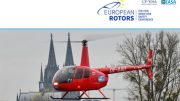Having the best possible aircraft available couldn’t be more critical than when it comes to the Helicopter Emergency Medical Services (HEMS) mission. For many emergency scenarios, helicopters remain the sole method of transporting patients to hospitals – whether it’s due to the patient being in an inhospitable prehospital location or because they need transfer to a hospital with a higher level of medical care.
In Europe, EASA law mandates that all helicopters used for the HEMS mission are twin engine to optimize safety, especially when operating in densely populated areas. Having access to a light twin engine aircraft which is fast, powerful and agile, such as the Bell 429, is essential.
“When you consider the ‘Golden Hour’ concept – the period immediately after a traumatic injury – the bottom line is that the more quickly a patient receives the treatment they need, the better their chances of survival,” said Steve Soliz, HEMS segment specialist, Bell.
“That’s why having the best possible aircraft for the mission matters, and when it comes to developing a helicopter for the HEMS mission, there are three key stakeholders which we consider: the pilots, the clinicians and the operators.”
For pilots: more performance, less workload
For HEMS pilots, speed, maneuverability and plenty of available power in reserve is crucial. With its dual Pratt & Whitney engines each delivering a max continuous 635 shp and enabling a max cruise speed of 278 km/hr, the Bell 429 ensures patients can be rapidly transported to hospitals at times where every second counts. In addition, the Bell 429’s digital engine control and avionics are designed to minimize pilot workload so that pilots can focus more of their attention on situational awareness, navigation and communication.
“In addition to high performance, we wanted to develop an aircraft that features more system redundancy, which ultimately optimizes the safety of the aircraft. For example, the Bell 429 has a system which prevents pilots from accidentally switching off the wrong engine in the event of an engine failure.
For clinicians: maximum space and refinement
When it comes to the on-board clinicians, cabin space and easy access are top priorities. The 429 offers the cabin space of larger aircraft but in a relatively small footprint which means it’s able to access more rooftops and landing pads and retrieve patients from locations with limited space available. The 429 has the widest door opening in its class (around a third wider than its competitors) and the flat cabin floor is the same height as the stretcher, so loading patients is made much easier. Patients can also be loaded from the side or using the optional rear clamshell doors, further enhancing the 429’s flexibility.
With four rotor blades, the Bell 429 offers an exceptional level of smoothness – another essential for clinicians who may be required to administer emergency treatment to patients whilst in the air.
For operators: reliability and configurability
For those operating and maintaining aircraft for HEMS missions, having an ultra-reliable platform with minimal maintenance downtime are key considerations. The Bell 429 excels in this area, benefitting from a high reliability, meaning the aircraft is mission ready, more of the time. Even for scheduled maintenance, the Bell 429 has shorter turnaround times than its competitors and rarely requires unscheduled maintenance, further reducing its downtime.
“The Bell 429 is available in three HEMS configurations, and we work closely with operators to configure the aircraft to their specific needs – whether it’s to maintain commonality with other aircraft on their fleet or to optimize the 429’s multi-mission capabilities,” added Soliz.
Using the Bell 429 for rescue missions with Air Zermatt
Air Zermatt, based in the southern Alps in Switzerland, operates two Bell 429s, with a third aircraft on order. Each year, Air Zermatt carry out around 2,000 rescue missions, the vast majority of which are with the Bell 429.
“We use the 429 for mountain rescue and hoist missions, frequently operating at altitudes of up to 4,600 m. This is where the 429’s impressive performance characteristics come into their own,” said Gerold Biner, CEO of Air Zermatt.
Biner, a pilot himself, obtained his first type rating on a Bell 206 Jet Ranger and has since accumulated close to 16,000 flight hours. He has extensive mountain rescue experience too, having carried out around 5,000 rescue missions.
“I remember the first time I flew in the Bell 429 on a demo flight, when we hovered above a mountain top at 4,600 m, and being impressed by its power, versatility, cockpit ergonomics and the reduction in pilot workload in IFR configuration.
“Not only that, with its large cabin capacity and excellent visibility, we knew immediately that this was going to be the ideal aircraft for our operations.
“It was the first time a manufacturer asked us what it is we need from the product, which meant we were able to work with Bell to help tailor the 429 to our requirements. That just about summarizes our customer experience with Bell – we have a great relationship with them, and they work closely with us to both optimize our current operations and make product developments which we can benefit from in the future,” added Biner.
There are over 400 Bell 429s in operation around the world, used for a multitude of missions including HEMS, corporate transportation and law enforcement. At the start of 2022, the Bell 429 exceeded 500,000 global fleet flight hours.
The Bell 429 will be on display at European Rotors from 8 to 10 November 2022. Please stop by stand number 1005 to learn more about the Bell 429 or visit bell.co/europeanrotors to find out more about Bell’s presence at the show.








Be the first to comment on "European Rotors – The aircraft designed to save lives: European HEMS operations with the Bell 429"